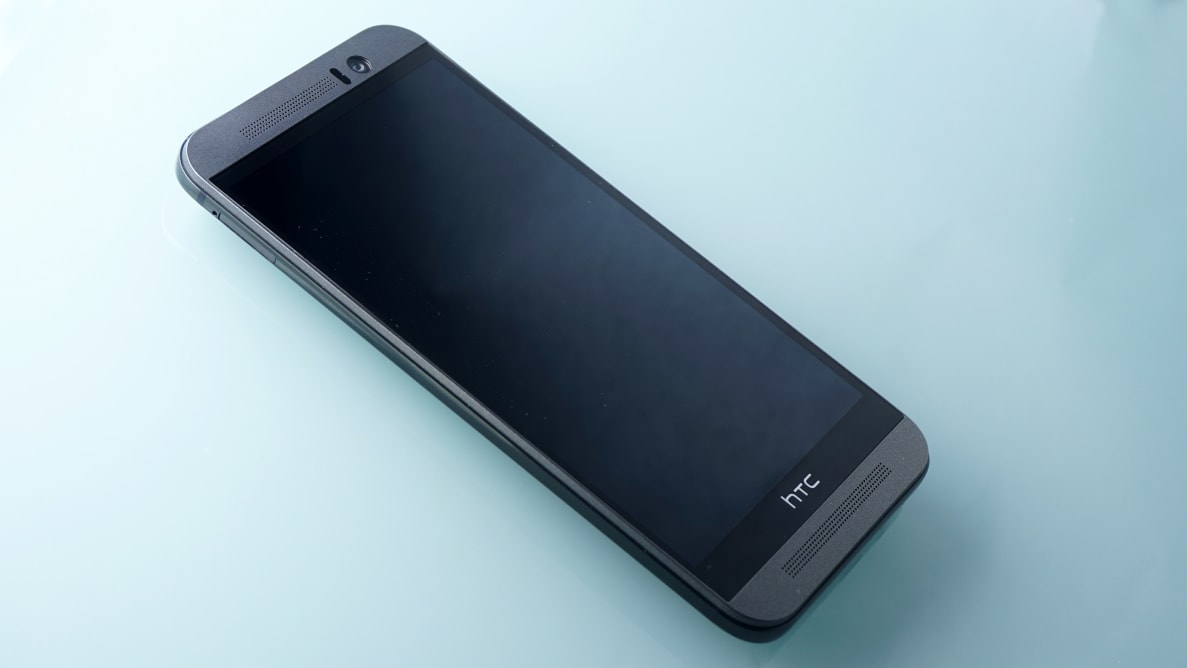HTC’s flagship series has certainly ebbed and flowed over the years, but last year’s HTC One M8 mastered the winning—and relatively difficult—formula of blending style with raw performance power. The result was a top-shelf smartphone that looked as smooth as it operated, putting competing flagships to shame. While not nearly as successful, it proved that HTC could make a phone every bit as beautiful as Apple's iPhone.
The HTC One M9 (MSRP $649 unlocked) is deja vu all over again; a slight reimagining of the same basic design with a couple of noteworthy hardware upgrades. This news might come as a disappointment for those people who were hoping that HTC would radically shift its aesthetic approach, but if you're comfortable with the M8's design, the M9 will be a delight.
Unfortunately, much like the HTC One M8, the M9 harbors a few shortcomings. Another year on and the state of smartphone cameras has only improved, leaving HTC at a severe disadvantage. And although it's battery is average, it still doesn't hold a candle to some of its ever-lasting Android peers.
But if you want a very good—and very good-looking—Android smartphone powered by one of the most powerful processors on the market, the HTC One M9 shouldn't be overlooked.
Design & Feel
Elegance incarnate
The HTC One M9’s cold, metallic body sits in your hand like the handle of a high-end chef’s knife. The craftsmanship here is phenomenal; the aluminum frame wraps around the body with nary a seam in sight. It’s all at once bold and yet reserved, eschewing the flashiness that defines fancier phones like the Samsung S6 Edge or LG G Flex 2.
If you’re used to light, plastic-backed smartphones, it might take a while to adjust to the heft of the M9; the phone is considerably heavier than any other that I’ve held recently. That said, over the few weeks I’ve spent with the phone, I’ve never felt as though its weight was a detriment. In other words, it doesn’t drag my pockets down.
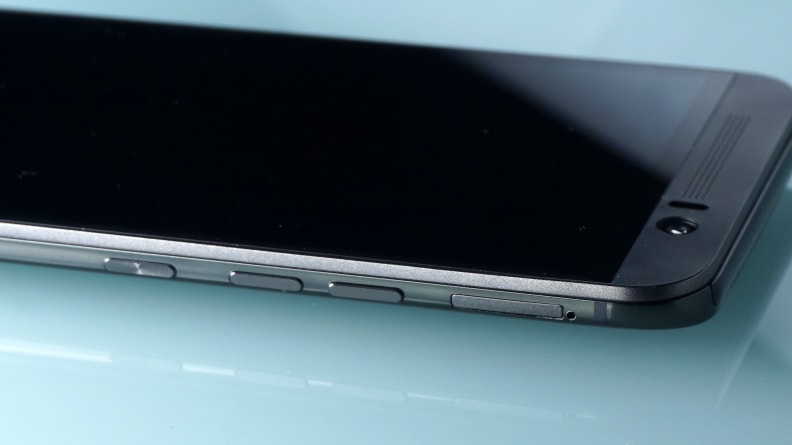
The volume buttons are the same size as the power button, which often leads to confusion.
In terms of day-to-day use, the most frustrating aspect of the M9 is its button placement. The volume rocker is located about a half-inch above the power button. All three individual buttons are roughly the same size and shape, turning something as easy as on-the-fly volume adjustments into a momentary guessing game. HTC did outfit the power button with some texture—a slightly raised, concentric pattern—but try as I might to remind myself to fish for the textured button, my brain always prioritizes size and shape.
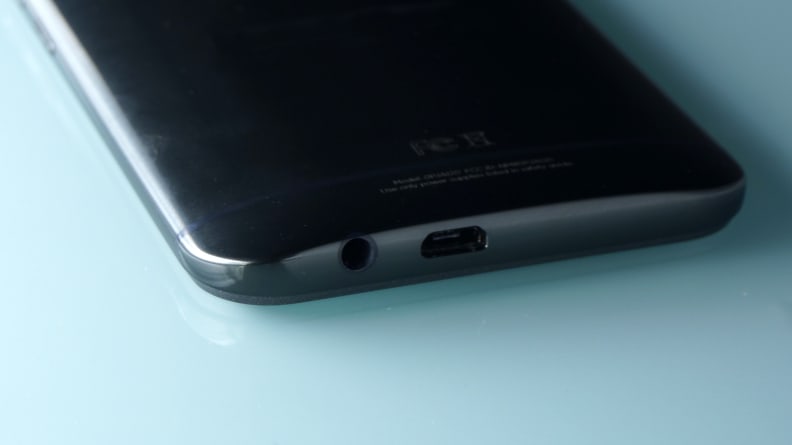
The M9's headphone jack is located on the bottom of the phone.
One of the more interesting elements of the M9 is the infrared sensor, which sits on the top of the phone. The sensor allows the phone to double as a remote control for your TV, cable box, or sound system. It's an interesting feature for a smartphone, but not at all a superfluous or unusual one. Several phones in recent memory—like the LG G3 and the Samsung Galaxy Note 4—have featured similar IR blasters.
Fans of the M7 and M8 will feel right at home when they pick up the M9. There are a few noticeable differences—the M9's camera, for instance, is slightly raised above the surface of the phone—but for the most part, this is the same sleek design we've come to know from earlier iterations in the the series.{{amazon name="SanDisk Ultra 32GB UHS-I/Class 10 Micro SDHC Memory Card Up to 48MB/s With Adapter- SDSDQUAN-032G-G4A [Newest Version]", asin="B00M55C0NS", align="right"}}
Perhaps the most exciting non-aesthetic feature of the phone is actually something that hasn't changed. While HTC still doesn't let you swap out the battery, you can add your own microSDHC memory cards to increase storage. That's incredibly valuable, as adding an extra 32GB of built-in storage for most smartphones jacks the price up by at least $100. A 32GB microSDHC memory card? About $10 online.
Performance
A high-caliber device
Pop the hood of the HTC One M9 and you’ll find an impressive array of hardware, which is only fitting, given the phone's top-shelf price tag.
First and foremost is the M9’s Snapdragon 810 chipset with a quad-core 1.5 GHz/2 GHz processor, which keeps the phone in tip-top shape during periods of high-demand. Unlike with earlier versions of the Snapdragon 810, we didn't notice any prolonged periods of throttling, so you should notice a sizable upgrade in speed over older Snapdragon 801 and 805 smartphones. Also responsible for the M9’s silky-smooth performance is the phone’s 3GB of RAM; a considerable amount, even for a phone of this class.
The M9 also comes equipped with 32GB of internal storage space. Again, when you factor in expandable microSDHC storage, you'll be able to leave plenty of room on your phone, which will help stave off the sluggishness that always plagues phones that are full of too many photos.
Its display gets commendably bright, as well–we measured a peak brightness of around 450 cd/m2 . It’s not the brightest phone on the block, but it’ll keep things manageable in the sunniest of conditions. You'll at least be able to make out roughly what's on your screen, so you can read text messages or see directions when at the beach.
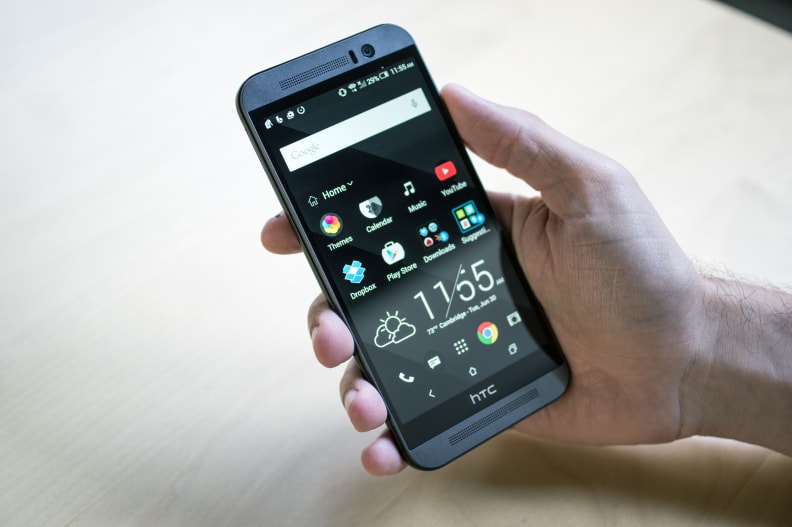
It’s not the brightest phone on the block, but it’ll keep things manageable in the sunniest of conditions.
If there's one area of performance where the M9 could stand to improve, it's battery life. We clocked the M9's battery at 5.3 hours of intense use and 8 hours of video playback. Although these test results smoke the likes of Apple's iPhone 6, they fall short of the high-water marks set by phones like the Sony Xperia Z3 Compact and the Google Nexus 6.
You'll comfortable see a day's worth of battery life with minor to moderate usage, but that's bound to go down over the life of the phone. And with the battery being non-removable, you're basically stuck with the one that comes with your phone. Heavy smartphone users will likely want to jump up to something like the Sony Z3 or Samsung Galaxy Note 4, as a result.
In Use
Smooth operator
In terms of routine, day-to-day use, the M9 glides along with the best of them. This thing can handle a ridiculous workload with relative ease; be it a stack of tabs in a browser, streaming video, or multitasking across several apps.
This can mostly be attributed to the M9's powerful processor, but the phone's Android skin also runs like a dream, too. The operating system is one that emphasizes personalization, which should delight users that want to free themselves of the shackles of, say, Apple's very rigid iOS.
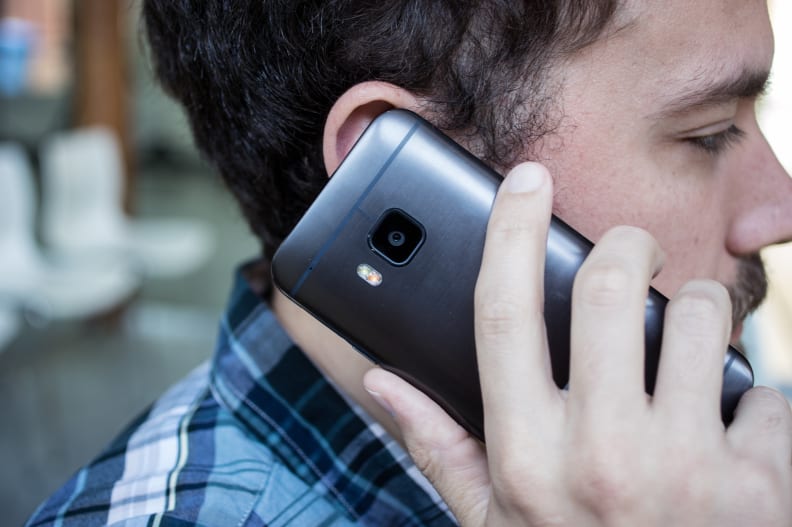
Take, for instance, the M9's ability to render pictures into custom themes: Simply choose a photo from your library, crop it to your liking, and the M9's software will source a color palette from your photo and custom-build a theme around it. The results aren't as good as some of the completely custom ROMs out there, but it allows you to switch up your entire phone every time that you find a background photo that you like.
All in all, the M9 simply feels like a high-octane device, which is appropriate given its high-octane price. There's a sense that the phone has been built from the ground-up for a comfortable, streamlined experience, and it delivers. If you've just been getting by with an older Android smartphone, or living with the chunky, bloated skins that other manufacturers stick you with, HTC's Sense UI will feel like a breath of fresh air.
Camera
Not an all-star but a useful utility player
The M9’s rear-facing 20-megapixel camera isn’t the best on the market, but it’s reliable in almost every condition, and its reliability makes its more posh features—4K video, HDR, RAW support—feel all the more enticing. And while this isn't the drastic improvement that many HTC fans were hoping for, the extra resolution is a step in the right direction.
The M9 performs best in adequately-to-brightly-lit environments. In darker settings, the camera struggles to reduce noise without crushing the finer details in an image (not unlike most smartphones). This manifests in poorly-defined edges and washed-out colors, especially in images that are viewed at 100%; they'll look fine on your phone and on Facebook, but prints are a no-go.
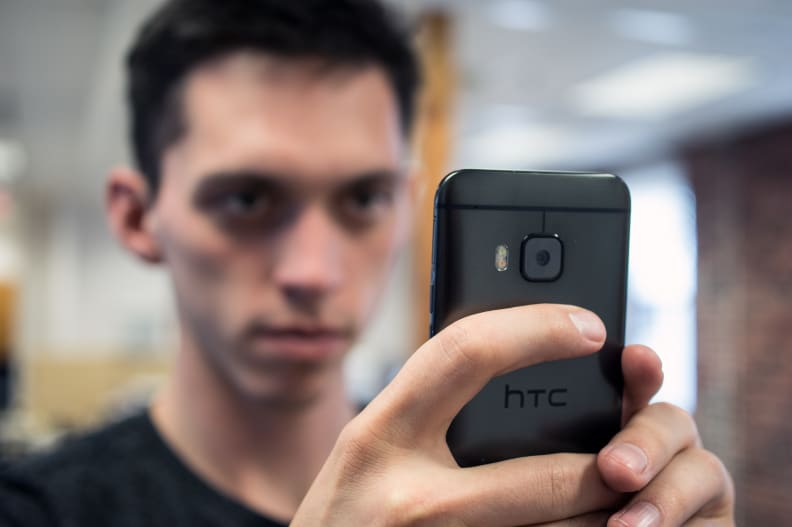
These issues don’t take a trained eye to see, either; even if you don’t fancy yourself a shutterbug, you’ll notice a steep drop-off in image quality in dimly-lit settings.
In brighter conditions, the 20-megapixel camera is capable of capturing some very sharp images. HTC helps this along with a little bit of oversharpening that can occasionally cause a halo effect around high-contrast edges, but it's not that noticeable.
The extra resolution does allow you to downsample your images further than before, which has a noticeably positive impact on the perceptual image quality of your shots. If you're pixel peeping at 100% you may not notice an improvement over the One M8, but at normal viewing distances (such as on the phone's screen itself) the shots will have higher acutance, giving the perception of sharper details.
Where HTC has made huge strides is in video. The mere inclusion of 4K video sets the One M9 apart from most smartphones, but the HTC doesn't just shoot UHD video—it does it very well.
{{ photo_gallery name="HTC One M9 Sample Photos" }}
The HTC One M9 absolutely aced our video sharpness test, showing an extreme resistance to frequency interference in all but extreme circumstances. Where most 1080p cameras are lucky to eke out around 650 line pairs per picture height (a measure of sharpness), the One M9 records over 1,100. In practice, this means that users needn’t worry about finer details—complex patterns and textures, especially—losing their edge or returning ugly, aliased results.
The M9 also handles motion with relative ease, with only scant traces of artifacting. For the most part, footage shot on the M9 is smooth and free of judder. It's not ideal in low light, but it'll manage. It also fights off the wobbling, rolling shutter effect better than most smartphones. It still happens, and can ruin a shot if you pan too aggressively, but it's better than we're used to seeing on smartphones.
A note about RAW photos
The HTC One M9 is capable of recording RAW images in the Adobe DNG format, which we used in some of our testing. The biggest gain you'll see with this format is in dynamic range—the range of tones from shadows to highlights that the camera can capture. With JPEGs we were lucky to get over 8.5 stops of range, which is barely on par with most point-and-shoots. In RAW we saw over 10, which would be close to DSLRs from a few years ago.
Unfortunately, although the M9’s camera is capable of shooting RAW images, the stock camera app’s basic settings—ISO, white balance, exposure compensation—don’t seem to be available for everyone.
A quick Google search indicates that a large swath of M9 owners are missing manual controls in this mode, despite a small minority that claim otherwise. Given the advantages of RAW, this isn’t the worst oversight in the world, but it’s a real head-scratcher, nonetheless. We expect this to be remedied eventually, but even after forcing an update on our loaner, it still lacked actual controls when RAW was activated.
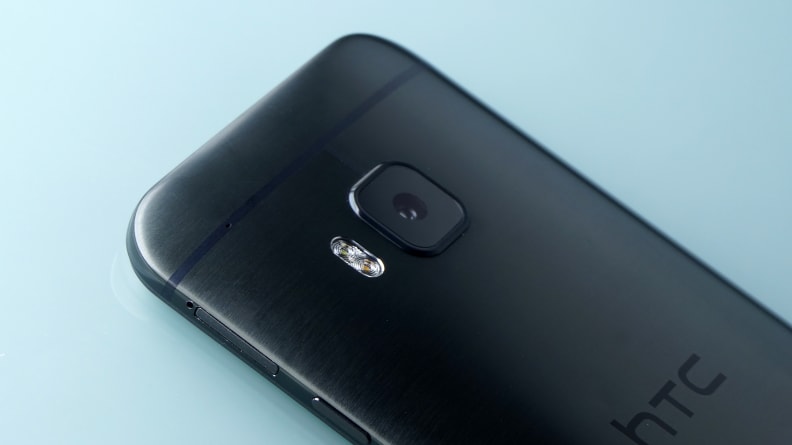
The HTC One M9 features a 20 megapixel camera.
That said, there are a number of premium camera apps that offer fully-functional manual controls for shooting in RAW, so sticklers for such things will ultimately find a way around the issue. Given that most smartphones can't take RAW shots at all, the HTC still has a leg up here.
The Verdict
A top-shelf phone with a few hang-ups
For the most part, the HTC One M9 performs as well as its elegant build—and its price tag—would lead you to believe. The only caveats are its somewhat limited battery life and a camera that isn't quite as good as the leading lights in the category.
Users looking for a camera that lends itself well to dim-to-low-light conditions would be better off going in a different direction. The iPhone 6 features an all-around better camera, especially in bright light.
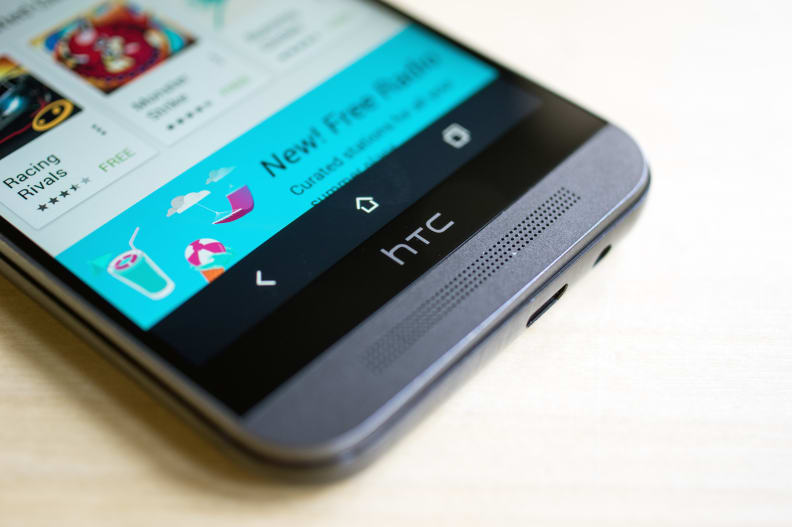
If iOS isn't your thing, there are certainly better alternatives within the Android family—namely, the Google Nexus 6 and the Sony Xperia Z3. Unlocked, these phones are just about the same price as the M9, but both represent significant upgrades in both the battery and camera departments.
Of course, they're also both much uglier. Though the Nexus 6 has its high points, the HTC One M9 is still the best-designed Android smartphone this side of the Samsung Galaxy S6 Edge. Pair that with the new Snapdragon 810 and—mediocre camera aside—you still have a heavy-hitting flagship phone that's worth all the praise we can throw at it.
While we're hopeful that HTC is focused on pushing the envelope of smartphone design even further next time around, if you're looking for a beautiful, no-nonsense Android flagship that stays out of your way, the HTC One M9 is it. There are better-performing phones on the market, but the One M9 belongs in the rare class of phone that is every bit as gorgeous as it is powerful.
Meet the tester
Michael Desjardin graduated from Emerson College after having studied media production and screenwriting. He specializes in tech for Reviewed, but also loves film criticism, weird ambient music, cooking, and food in general.
Checking our work.
Our team is here to help you buy the best stuff and love what you own. Our writers, editors, and experts obsess over the products we cover to make sure you're confident and satisfied. Have a different opinion about something we recommend? Email us and we'll compare notes.
Shoot us an email
